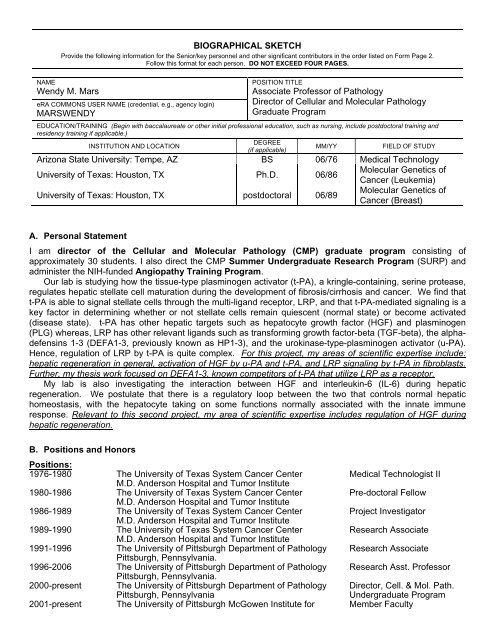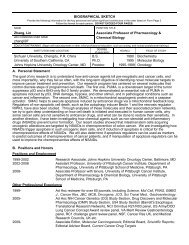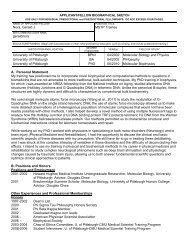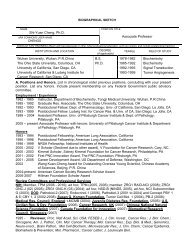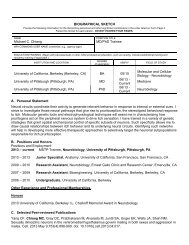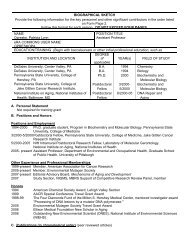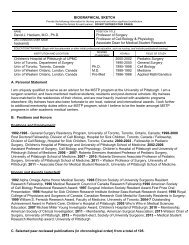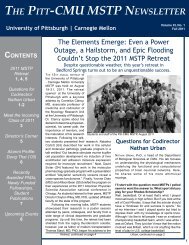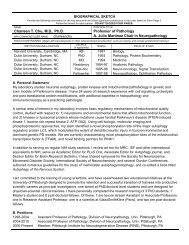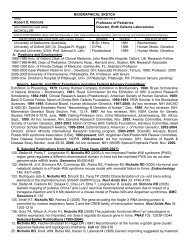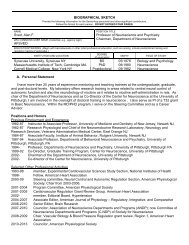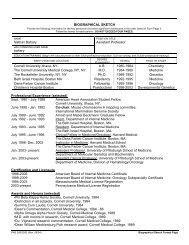BIOGRAPHICAL SKETCH Wendy M. Mars Associate Professor of ...
BIOGRAPHICAL SKETCH Wendy M. Mars Associate Professor of ...
BIOGRAPHICAL SKETCH Wendy M. Mars Associate Professor of ...
You also want an ePaper? Increase the reach of your titles
YUMPU automatically turns print PDFs into web optimized ePapers that Google loves.
<strong>BIOGRAPHICAL</strong> <strong>SKETCH</strong>Provide the following information for the Senior/key personnel and other significant contributors in the order listed on Form Page 2.Follow this format for each person. DO NOT EXCEED FOUR PAGES.NAME<strong>Wendy</strong> M. <strong>Mars</strong>eRA COMMONS USER NAME (credential, e.g., agency login)MARSWENDYPOSITION TITLE<strong>Associate</strong> <strong>Pr<strong>of</strong>essor</strong> <strong>of</strong> PathologyDirector <strong>of</strong> Cellular and Molecular PathologyGraduate ProgramEDUCATION/TRAINING (Begin with baccalaureate or other initial pr<strong>of</strong>essional education, such as nursing, include postdoctoral training andresidency training if applicable.)DEGREEINSTITUTION AND LOCATIONMM/YYFIELD OF STUDY(if applicable)Arizona State University: Tempe, AZ BS 06/76 Medical TechnologyUniversity <strong>of</strong> Texas: Houston, TX Ph.D. 06/86Molecular Genetics <strong>of</strong>Cancer (Leukemia)University <strong>of</strong> Texas: Houston, TX postdoctoral 06/89Molecular Genetics <strong>of</strong>Cancer (Breast)A. Personal StatementI am director <strong>of</strong> the Cellular and Molecular Pathology (CMP) graduate program consisting <strong>of</strong>approximately 30 students. I also direct the CMP Summer Undergraduate Research Program (SURP) andadminister the NIH-funded Angiopathy Training Program.Our lab is studying how the tissue-type plasminogen activator (t-PA), a kringle-containing, serine protease,regulates hepatic stellate cell maturation during the development <strong>of</strong> fibrosis/cirrhosis and cancer. We find thatt-PA is able to signal stellate cells through the multi-ligand receptor, LRP, and that t-PA-mediated signaling is akey factor in determining whether or not stellate cells remain quiescent (normal state) or become activated(disease state). t-PA has other hepatic targets such as hepatocyte growth factor (HGF) and plasminogen(PLG) whereas, LRP has other relevant ligands such as transforming growth factor-beta (TGF-beta), the alphadefensins1-3 (DEFA1-3, previously known as HP1-3), and the urokinase-type-plasminogen activator (u-PA).Hence, regulation <strong>of</strong> LRP by t-PA is quite complex. For this project, my areas <strong>of</strong> scientific expertise include:hepatic regeneration in general, activation <strong>of</strong> HGF by u-PA and t-PA, and LRP signaling by t-PA in fibroblasts.Further, my thesis work focused on DEFA1-3, known competitors <strong>of</strong> t-PA that utilize LRP as a receptor.My lab is also investigating the interaction between HGF and interleukin-6 (IL-6) during hepaticregeneration. We postulate that there is a regulatory loop between the two that controls normal hepatichomeostasis, with the hepatocyte taking on some functions normally associated with the innate immuneresponse. Relevant to this second project, my area <strong>of</strong> scientific expertise includes regulation <strong>of</strong> HGF duringhepatic regeneration.B. Positions and HonorsPositions:1976-1980 The University <strong>of</strong> Texas System Cancer Center Medical Technologist IIM.D. Anderson Hospital and Tumor Institute1980-1986 The University <strong>of</strong> Texas System Cancer Center Pre-doctoral FellowM.D. Anderson Hospital and Tumor Institute1986-1989 The University <strong>of</strong> Texas System Cancer Center Project InvestigatorM.D. Anderson Hospital and Tumor Institute1989-1990 The University <strong>of</strong> Texas System Cancer Center Research <strong>Associate</strong>M.D. Anderson Hospital and Tumor Institute1991-1996 The University <strong>of</strong> Pittsburgh Department <strong>of</strong> Pathology Research <strong>Associate</strong>Pittsburgh, Pennsylvania.1996-2006 The University <strong>of</strong> Pittsburgh Department <strong>of</strong> Pathology Research Asst. <strong>Pr<strong>of</strong>essor</strong>Pittsburgh, Pennsylvania.2000-present The University <strong>of</strong> Pittsburgh Department <strong>of</strong> Pathology Director, Cell. & Mol. Path.Pittsburgh, PennsylvaniaUndergraduate Program2001-present The University <strong>of</strong> Pittsburgh McGowen Institute for Member Faculty
Regenerative Medicine, Pittsburgh, Pennsylvania2006-present The University <strong>of</strong> Pittsburgh Department <strong>of</strong> Pathology <strong>Associate</strong> <strong>Pr<strong>of</strong>essor</strong>Pittsburgh, Pennsylvania.2006-present The University <strong>of</strong> Pittsburgh Department <strong>of</strong> Pathology Director, Cell. & Mol. Path.Pittsburgh, PennsylvaniaGraduate ProgramHonors:2010-2011 Awarded University <strong>of</strong> Pittsburgh School <strong>of</strong> Medicine Distinguished Mentor AwardC. Selected Peer-reviewed PublicationsMost relevant to the described projects:1. <strong>Mars</strong>, W.M., vanTuinen, P., Drabkin, H.A., White, J.W., and Saunders. G.F.: A myeloid-relatedsequence that localizes to human chromosome 8q21.1-22. Blood 71, 1713-1719 (1988). PMID:33703152. <strong>Mars</strong>, W.M., Zarnegar, R., and Michalopoulos, G.: Activation <strong>of</strong> hepatocyte growth factor by theplasminogen activators uPA and tPA. Amer J Path 143, 949-958 (1993). PMID: 8362987,PMC18872223. Liu, M.-L., <strong>Mars</strong>, W.M., Zarnegar, R., and Michalopoulos, G.K.: The uptake and distribution <strong>of</strong> hepatocytegrowth factor in normal and regenerating adult rat liver. Amer J Path 144, 129-139 (1994).PMID: 8291602, PMC18871164. <strong>Mars</strong>, W.M., Liu, M.-L., Kitson, R.P., Goldfarb, R., Gabauer, M., and Michalopoulos, G.K.: Immediateearly detection <strong>of</strong> urokinase receptor after partial hepatectomy and its implications for initiation <strong>of</strong> liverregeneration. Hepatology 21, 1695-1701 (1995). PMID: 77685155. <strong>Mars</strong>, W.M., Patmasiriwat, P., Maity, T., Huff, V., Siciliano, M., Weil, M., and Saunders, G.F.:Inheritance <strong>of</strong> unequal numbers <strong>of</strong> the genes encoding the human neutrophil defensins HP-1 and HP-3.J Biol Chem 270, 30371-30376 (1995). PMID: 85304626. <strong>Mars</strong>, W.M., Kim, T.-H., Stolz, D. B., Liu, M.-L., and Michalopoulos, G.K.: The presence <strong>of</strong> urokinase inserum-free, primary rat hepatocyte cultures and its role in activating hepatocyte growth factor. CancerRes. 56, 2837-2843 (1996). PMID: 86655237. Yang, Y., Shultz, R.W., <strong>Mars</strong>, W.M., Wegner, R.E., Dai, C., Nejak, K., and Liu, Y.: Disruption <strong>of</strong> tissuetypeplasminogen activator gene in mice reduces renal interstitial fibrosis in obstructive nephropathy byselective blockade <strong>of</strong> epithelial to my<strong>of</strong>ibroblast transition. J Clin Invest. 110, 1525-1538, (2002).PMID: 12438450, PMC1518178. Michalopoulos, G.K., Bowen, W.C., Mule, K., Lopez-Talavera, J.C., and <strong>Mars</strong>, W.M.: Hepatocytesundergo phenotypic transformation to biliary epithelium in organoid cultures. Hepatology 36, 278-283,(2002). PMID: 12143035, PMC17693349. Ma, Z., Thomas, K.S., Webb, D.J., Moravec, R., Salicioni, A.M., <strong>Mars</strong>, W.M., and Gonias, S.L.:Regulation <strong>of</strong> Rac1 activation by the low density lipoprotein receptor-related protein J Cell Biol 159,1061-1070, (2002). PMID: 12499359, PMC217398910. Schoedel, K.E., Michalopoulos, G.K., Tyner, V.Z., Kim, T-H., and <strong>Mars</strong>, W.M.: Discernable differencesin MET/HGF and matrix-related proteases in hepatocellular carcinoma, fibrolamellar variant, cirrhoticand normal liver. Modern Pathol 16, 14-21, (2003). PMID: 1252770811. Lagoa, C.E., Vodovotz, Y., Stolz, D.B. Lluillier, F., McCloskey, C., Gallo, D., Yang, R., Ustinova, E.,Fink, M., Billiar, T.R. and <strong>Mars</strong>, W.M. Contribution <strong>of</strong> type 1 plasminogen activator inhibitor (PAI-1) tohepatic injury during hemorrhagic shock. Hepatology 42, 390-399 (2005). PMID: 1602551012. Hu, K., Yang, J., Tanaka, S., Gonias, S.L., <strong>Mars</strong>, W.M., and Liu, Y. Tissue-type plasminogen activatoracts as a cytokine that triggers intracellular signal transduction and induces matrix metalloproteinase-9gene expression. J Biol Chem 281, 2120-2127 (2006). PMID: 1630377113. Hu, K., Wu, C., <strong>Mars</strong>, W.M. and Liu, Y. tPA promotes my<strong>of</strong>ibroblast activation through LRP-1-mediatedrecruitment <strong>of</strong> integrin signaling. J Clin Invest. 117, 3821-3832 (2007). PMID: 18037995, PMC208214314. Lin, L., Bu, G., <strong>Mars</strong>, W.M., Reeves, W.B., Tanaka, S., and Hu, K. tPA promotes renal interstitialfibroblast proliferation through LDL receptor-related protein 1-mediated p90RSK and GSK3betasignaling. Am. J. Path. 177, 1687-1696 (2010). PMID: 20724593, PMC2947266.15. Coudriet, G.M., He, J., Trucco, M., <strong>Mars</strong>, W.M. and Piganelli, J.D. Hepatocyte Growth FactorModulates Interleukin-6 Production in Bone Marrow Derived Macrophages: Implications For
Inflammatory Mediated Diseases. PLoS ONE 5 (11): e15384 (2010). PMID: 21072211, PMC297055916. Norris, C.A., He, M., Kang, L.-I., Ding, M. Q., Radder, J.E., Haynes, M.M., Yang, Y., Paranjpe, S.,Bowen, W.C., Orr, A., Michalopoulos, G.K., Stolz, D. B. and <strong>Mars</strong>, W.M. Synthesis <strong>of</strong> IL-6 byhepatocytes as a frequent response to common hepatic stimuli. (in press, PLoS ONE)D. Research SupportOngoing Research SupportRO1 CA103958 Michalopoulos (PI) 6/6/10-4/30/15HGF and signaling pathways in hepatic tissue assemblySupervision <strong>of</strong> studies related to generation and utilization <strong>of</strong> a “knock in” mouse with a floxed HGF gene, foruse in studies <strong>of</strong> the role <strong>of</strong> HGF in hepatic tissue.Role: co-investigator-15%T32 HL094295 <strong>Mars</strong> (PI) 7/1/10-6/30/15Angiopathy Training Program.A cross-university training program designed to educate students in vascular pathology, with a particularemphasis on imaging techniques. The ATP is administratively set up in a way that deliberately integratesstudents and faculty from a variety <strong>of</strong> disciplines.Role: PI-0%


